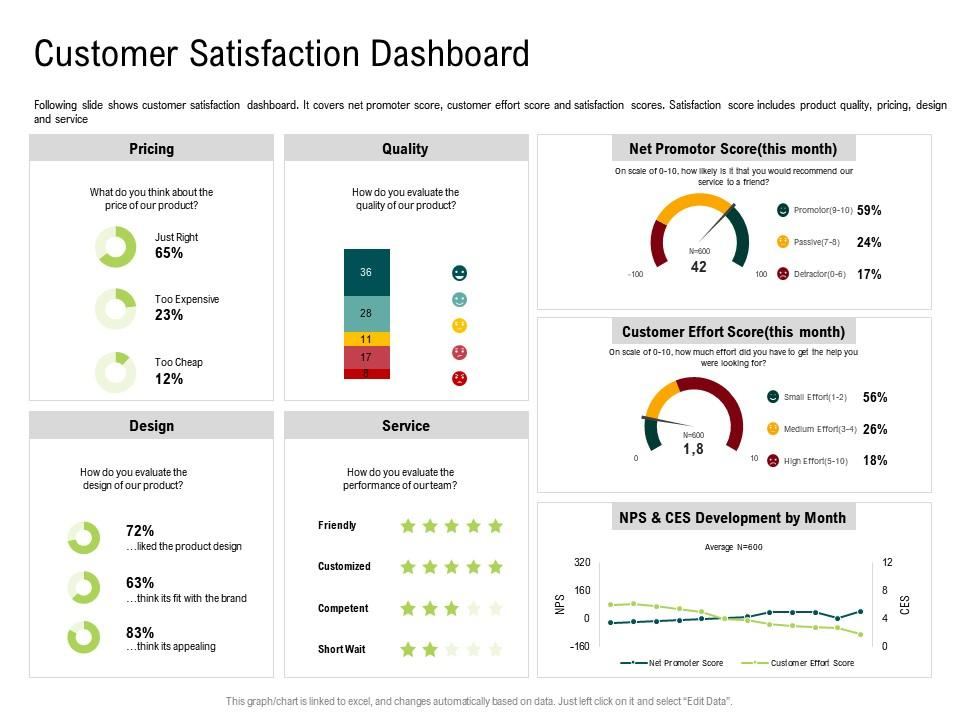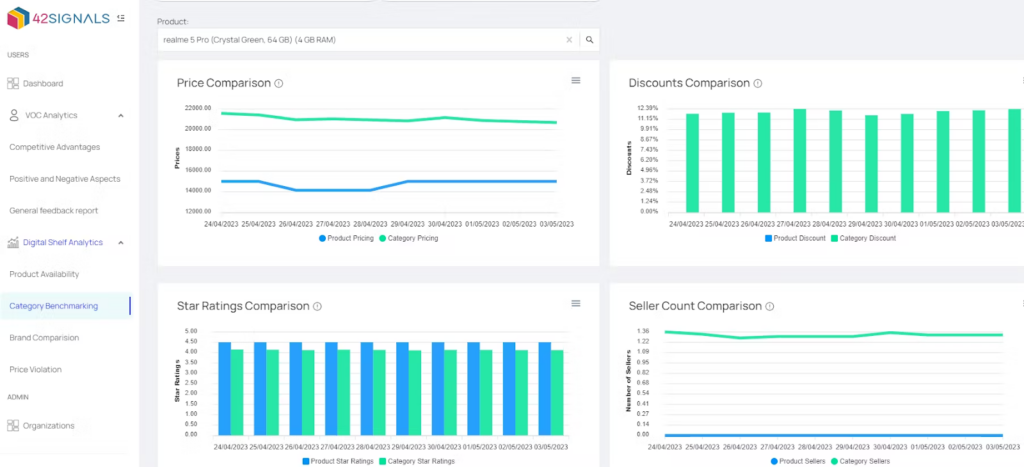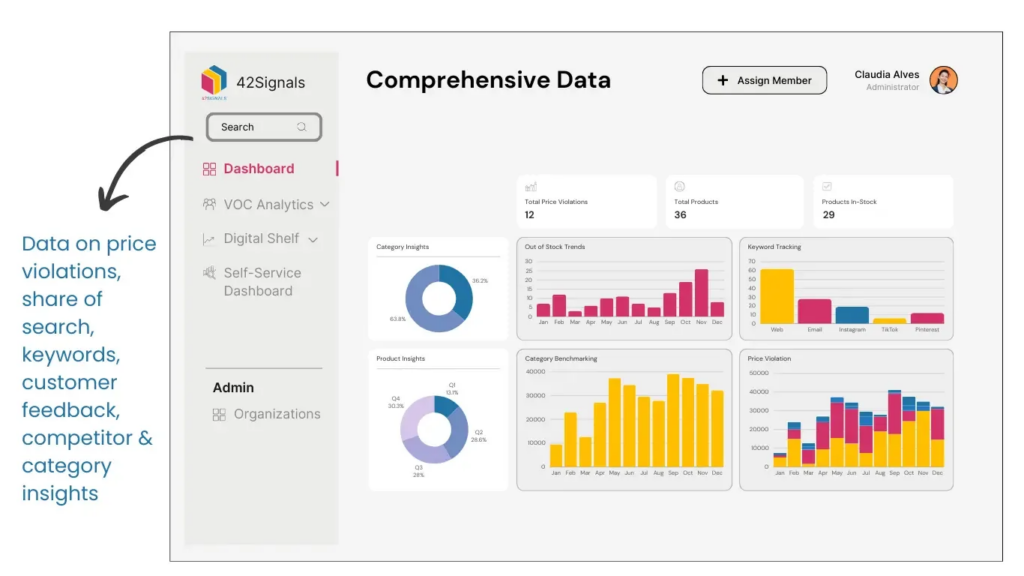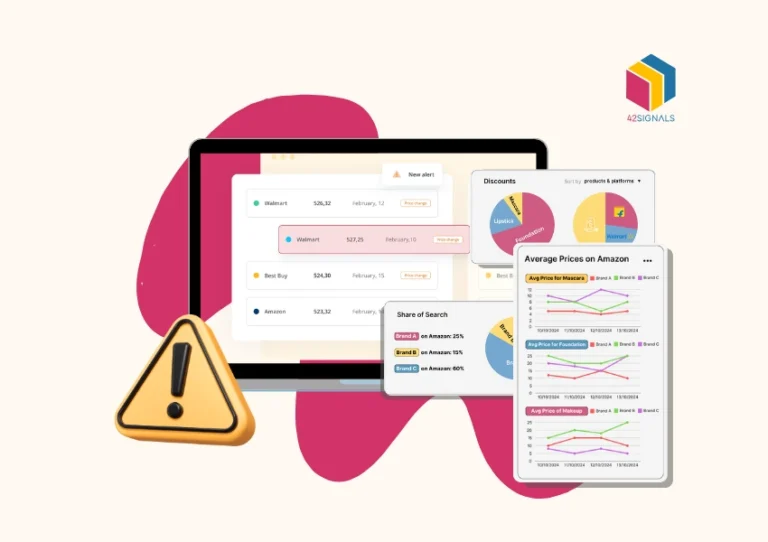Table of Contents
ToggleA Competitor price monitoring tool works by continuously scanning the web for information about rival brands and products. By analyzing data such as product descriptions, features, and pricing, these tools provide valuable insights into how competing businesses are positioning themselves in the market. This enables online retailers to make informed decisions about their pricing strategies, ensuring they remain competitive while still maintaining healthy profit margins.
The Benefits of Using a Competitor Monitoring Tool
1. Customer Satisfaction
One key benefit of using such software is improved customer satisfaction. By keeping a close eye on what other businesses are charging, e-commerce companies can ensure they offer competitive prices without sacrificing quality or service.

Image Source: Slide Team
This helps build trust with customers, who are likely to return again and again when they know they can rely on fair pricing and excellent value. Additionally, offering competitive prices can help attract new customers, further fueling growth and expansion.
While competitive pricing attracts customers, consistent value perception retains them. A competitor monitoring tool enables businesses to:
- Avoid underpricing (eroding brand value) or overpricing (losing price-sensitive shoppers).
- Identify “value gaps”: If competitors charge more for identical products, highlight your superior shipping/returns policy to justify matching their price.
- Leverage psychological pricing: Spot trends like charm pricing ($19.99 vs. $20) or bundle deals in your niche.
Example
Suppose you run an electronics store specializing in gaming equipment. A competitor suddenly drops its prices on high-end graphics cards right before Black Friday. Thanks to price monitoring tools, you receive immediate notification and promptly adjust your prices accordingly. Customers appreciate your keen sense of timing and affordable rates, ultimately leading to increased sales and positive reviews.
2. Efficiency with a Competitor Monitoring Tool
Another advantage of utilizing a price monitoring tool is increased efficiency. Rather than manually searching websites and comparing prices, businesses can automate this process using sophisticated software solutions. Not only does this save time and resources, but it also reduces the risk of errors and oversights.
Manual price tracking is unsustainable: Checking 50 products across 10 competitors takes ~25 hours/week. Monitoring tools solve this by:
- Automating 95% of data collection: Real-time alerts for price drops, stock changes, or new listings.
- Providing dynamic dashboards: Track pricing trends, MAP compliance, or margin health in one view (e.g., 42Signals’ visual competitor analytics).
- Enabling bulk adjustments: Update 500 SKUs in minutes during flash sales.
Pro Tip: Use geo-specific monitoring to see regional pricing tactics. A tool like Qualtrics might show a competitor testing higher prices in affluent ZIP codes – allowing you to replicate this profitably.
Impact: Teams reclaim 20+ hours/week for high-value tasks like customer engagement or strategy

Image Source: 42Signals App
Furthermore, many tools come equipped with advanced analytics capabilities, enabling users to visualize trends and patterns in real-time. This allows for quicker decision-making and better overall strategic planning.
Fun Fact: Did you know? Some competitor price monitoring tools allow you to customize alerts based on specific criteria, such as percentage differences or minimum/maximum price ranges. 42Signals, for instance, allows you to evaluate all aspects of your competitor’s strategies online to improve offerings.
3. Innovation
In addition to improving customer satisfaction and increasing efficiency, price monitoring software can also drive innovation within organizations. By studying competitors’ offerings and identifying gaps or opportunities, businesses can develop new products and services that cater specifically to consumer needs.
Competitor pricing isn’t just reactive – it’s a trend radar for innovation:
- Gap Analysis: Spot overpriced categories ripe for disruption (e.g., $40 organic cotton socks with no design innovation).
- Feature Benchmarking: If rivals charge 15% more for “anti-odor” workout gear, invest in developing superior fabric tech.
- Bundle Opportunities: Notice camera sellers discounting lenses but not tripods? Create a “starter bundle” at a strategic price point.

Image Source: Bootcamp
For example, if a competitor is consistently underpricing a particular item, an e-commerce company might decide to invest in creating a superior version at a similar price point. Alternatively, they may choose to focus on niche markets where there is less competition and higher demand.
Another use case, for example, would be a niche clothing brand targeting environmentally-conscious shoppers looking for sustainable materials. Upon discovering no direct competitors focusing exclusively on organic cotton socks, the company can begin producing stylish designs made entirely from organically sourced cotton yarn, effectively setting themselves apart from generic brands flooding Amazon listings.
4. Risk Management
A competitor price monitoring tool can help mitigate risks associated with fluctuating market conditions. By tracking changes in competitors’ pricing strategies, businesses can anticipate potential shifts in supply and demand and adjust their strategies accordingly. This proactive approach not only protects profits but also positions businesses as leaders in their industries, capable of adapting quickly to changing circumstances.
Price volatility can erode margins overnight. Monitoring tools act as an early-warning system:
- MAP Violation Alerts: Protect brand integrity by spotting unauthorized discounts.
- Demand Forecasting: A sudden 20% price drop by 3+ competitors may signal oversupply – pause stock orders.
- Tariff/Duty Impact: Track cross-border competitors; if they raise prices due to new tariffs, adjust yours proactively.
Crisis Scenario:
When shipping costs spiked in 2022, brands using tools like Price2Spy detected rivals:
- Increase prices on low-margin items first.
- Offering “free shipping” thresholds instead of blanket hikes.
This allowed strategic, phased adjustments – avoiding customer backlash.
Tips for Choosing the Best Competitor Monitoring Tool
When selecting a price monitoring tool, it is essential to consider factors such as –

✅ User-Friendly Interface: Select a competitor price monitoring tool that team members across departments can navigate effortlessly. Ease of use ensures smoother adoption and minimizes training requirements.
✅ Scalability: Pick a versatile option that caters to both small startups and large corporations. As your business expands, your monitoring tool should grow alongside it without missing a beat.
✅ Seamless Integrations: Prioritize solutions compatible with your current setup. Avoid unnecessary complexities by opting for a system that interacts flawlessly with pre-existing platforms and processes.
✅ Top-Notch Support: Rely on dependable tech assistance and routine updates to guarantee peak performance. Experts resolve issues efficiently, giving you priceless peace of mind.
Ideally, the chosen solution should be user-friendly, allowing employees across various departments to access relevant data easily. It should also have the ability to scale up or down depending on business needs, seamlessly integrating with existing systems and processes. Moreover, reliable technical support and ongoing maintenance are critical components of any successful implementation.
It is worth noting that implementing such software is just one aspect of a comprehensive online retail strategy.
Other elements, such as search engine optimization (SEO), social media marketing, and email campaigns, play equally important roles in driving traffic, converting leads, and fostering long-term relationships with customers.
Key Takeaways

Image Source: Mayple
- Competitor price monitoring tools improve customer satisfaction by helping you maintain competitive pricing and avoid underselling yourself.
- Automated competitor analysis saves time and increases operational efficiency compared to manual methods.
- Innovative thinking sparks new ideas and sets you apart from competitors, especially when addressing untapped niches or emerging trends.
- Proactive risk management techniques shield against volatile market forces, protecting revenue streams and preserving customer confidence.
- Choosing the ideal software involves considering factors such as usability, scalability, compatibility, and support.
Conclusion on Competitor Price Monitoring Tool | Action Steps
☑️ Research available competitor price monitoring tools, taking note of their respective features and limitations. Compare options side-by-side to narrow down choices based on budget constraints and business goals.
☑️ Schedule demos or trial periods with top contenders, inviting feedback from multiple stakeholders within your organization. Gather input regarding ease of use, interface design, reporting capabilities, and other essential aspects.
☑️ Evaluate each candidate’s capacity for integration with existing infrastructure, verifying whether APIs, plugins, or connectors streamline communication between disparate applications. Determine which configurations yield maximum ROI without causing additional strain on internal IT teams.
☑️ Assess vendor reputations and track records, favoring providers known for exceptional customer care, timely bug fixes, and frequent feature releases. Establish clear expectations around response times, escalation procedures, and accountability measures.
☑️ Implement selected tools incrementally, granting ample time for staff training and familiarization. Gradual rollouts minimize disruption and promote buy-in from employees accustomed to established routines.
☑️ Continually monitor performance metrics related to customer retention, conversion rates, basket sizes, and average order values. Leverage these KPIs to fine-tune pricing strategies and justify continued investment in competitor price monitoring technologies.
Stay competitive and enhance your sales with 42Signals’ Competitor Price Monitoring Tool! Equipped with real-time alerts, advanced analytics, and customizable settings, 42Signals grants you exclusive access to your competitor’s strategies like never before. Schedule a demo or sign up now to unlock your full potential!
Frequently Asked Questions
How to check competitor pricing?
You can check competitor pricing through a combination of manual research and automated tools:
- Visit their websites or online stores to view listed prices.
- Track prices on marketplaces like Amazon, Walmart, or eBay.
- Sign up for newsletters to catch promotional discounts.
- Use competitor price monitoring tools like 42Signals, which collect and update pricing data automatically.
- Follow them on social media to spot sales campaigns and flash deals.
Automated tools are more efficient for businesses that need daily or real-time updates across multiple platforms.
How do you evaluate competitors’ prices?
Evaluating competitors’ prices involves more than just looking at the numbers. You should consider:
- Base Price vs. Final Price – Include discounts, shipping, and taxes.
- Value Proposition – Compare what’s included for the price (quality, warranty, services).
- Price Positioning – See if they’re targeting a premium, mid-range, or budget audience.
- Market Trends – Check if their pricing aligns with seasonal demand or market shifts.
- Frequency of Changes – Understand how often they adjust prices to remain competitive.
The aim is to see how your pricing stacks up and where you can gain an advantage.
What is a competitor pricing dashboard?
A competitor pricing dashboard is a visual tool that centralizes real-time and historical data on your competitors’ prices. It helps businesses track and analyze pricing trends across multiple products, regions, and platforms.
Typical features include:
- Current competitor prices and promotions
- Price change alerts
- Market share comparisons
- Historical pricing trends
- Stock availability tracking
Tools like 42Signals offer customizable dashboards that allow brands to make quick, data-driven pricing decisions.
What is a competitor price analysis?
Competitor price analysis is the process of studying competitors’ pricing strategies to understand their positioning in the market. It helps you identify gaps, opportunities, and threats in your own pricing approach.
This analysis typically includes:
- Collecting competitor pricing data
- Comparing it with your own prices and value offering
- Understanding their discount cycles and promotional tactics
- Mapping their pricing strategy to customer segments
The insights gained help businesses decide whether to match, undercut, or differentiate their pricing for maximum profitability.




